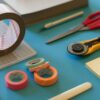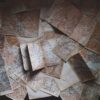Understanding Your Coffee Table
Before we roll up our sleeves and get into the nitty-gritty of refinishing, it’s wise to take a moment to size up the structure and current state of your coffee table. I’ll walk you through figuring out what it’s made of and giving it a once-over.
Surface Materials
Knowing what your coffee table’s surface is made from will steer your refinishing game plan. Different tables come with their own bag of tricks:
Solid Wood
- This bad boy’s perfect for a makeover. Its thickness can tackle sanding and staining head-on.
- Think classic beauties like oak, maple, and walnut.
Veneer
- Imagine a thin layer of swanky wood slapped onto cheaper stuff like plywood. It’s possible to refinish, but you’ll need kid gloves to protect that delicate veneer (Architectural Digest).
Laminate
- More plastic than wood, this material isn’t up for refinishing. Your best bet might be slapping on some paint or a cover (Architectural Digest).
| Material | Refinishing Suitability | Characteristics |
|---|---|---|
| Solid Wood | High | Thick, durable, can handle sanding and staining like a champ. |
| Veneer | Medium | Thin slice of real wood; take it easy to keep from wearing right through. |
| Laminate | None | Made of plastic, can’t be sanded or stained, but it’s fair game for repainting. |
Inspection and Assessment
Checking out the condition of your coffee table is a key move to get this refinishing show on the road. Here’s how I go about it:
Check for Structural Damage
- Is anything loose? Any legs wobbling like they’ve had too much coffee? Fix those before getting into the refinishing (DeCasa Collections).
- A dab of wood glue and some clamps should sort out any shaky bits.
Identify Surface Imperfections
- Hunt down scratches, dents, water rings, or spots marked by too-hot mugs. You’ll want to deal with these for a smooth finish (Castlery).
- Mark trouble spots for attention like filling or sanding.
Evaluate Existing Finish
- Is it painted, varnished, or stained? Each calls for a different removal method.
- Test a secret patch with a bit of paint remover to see what you’re dealing with.
For a deeper dive into sprucing up your coffee table, check out our article on coffee table makeover ideas.
Understanding what you’ve got and giving it a good inspection guarantees a refinishing job that transforms your table from blah to brilliant!
Preparation for Refinishing
So you’re looking to give that tired old coffee table a new lease on life, eh? The secret sauce to getting showroom-worthy results lies in – you guessed it – prep work. Cleaning up the table and kicking that outdated finish to the curb is where the magic starts.
Cleaning and Degreasing
Before you jump into slathering chemicals or whipping out the sander, you’ve got a date with soap and water. Dirt, oil, and grime have no business hanging around while you’re trying to work your magic. I grabbed my trusty all-purpose cleaner and gave that table a thorough scrubbing. It’s like setting the stage before the big show (Architectural Digest).
Here’s your cleaning mission, should you choose to accept it:
- Gather Supplies: Grab an all-purpose cleaner, a scrub brush, dish soap, and maybe some water to spruce it up.
- Initial Cleaning: Hit the table with the cleaner and brush, evicting every last speck of dirt and grease.
- Deep Cleaning: After that, blend dish soap with water and have another round to finish off any hangers-on.
- Drying: Let it chill for a few hours until it’s bone dry.
Removing the Old Finish
Once your table’s squeaky clean and looking sharp, it’s time to nix that ratty old finish. You’ve got two main routes here: chemical stripper or good old-fashioned sanding. Each has its perks, kinda like choosing between a cupcake and a brownie. Both will get you there, so pick what floats your boat and fits the table’s condition best.
- Chemical Stripping: Slather on a stripper like you’re frosting a cake, following the directions on the can. Best for those nooks and crannies you can’t hit with sandpaper.
- Sanding: Skip the chemicals? No biggie. Start with a coarse-grit sandpaper (60-grit), then go finer, like you’re carving a masterpiece (The Craftsman Blog).
Sanding game plan:
| Sandpaper Grit | What It Does |
|---|---|
| 60-grit | Tears off the old finish |
| 80-grit | Evens out deeper grooves |
| 120-grit | Lays the groundwork for stain |
| 220-grit | Smooths for a nice finish |
| 320-grit | The final polish |
- Initial Sanding: Start with 80-grit and a random orbit sander, but get some fresh air while you’re at it; that dust is unforgiving (The Craftsman Blog).
- Further Sanding: Gliding up the grit ladder (120, 220, 320) makes sure your table’s smoother than a jazz quartet on a Saturday night.
With the grime of yesteryears and beaten finish out the window, you’ve got a clean slate to work your magic. For more jazzy tips and a fistful of coffee table makeover inspirations, take a peek at our handpicked coffee table makeover ideas.
Restoring Your Coffee Table
When it comes to sprucing up your trusty coffee table, a few clever tweaks can be the game-changer in making it shine. Whether you’re tackling a wobbly leg or giving it a face-lift, knowing the tricks of the trade can transform your project from sad to sensational.
Repairing Structural Damage
Start your restoration by giving the table a health check-up for any signs of structural issues. This might mean dealing with anything from gnawed corners thanks to a teething puppy to wobbly joints. I highly suggest grabbing a tub of wood epoxy for major issues like chewed edges. You can shape it before it sets rock-hard, making it a handy fix for serious repairs.
For smaller hiccups like nail imperfections or teeny gouges, try Minwax’s Stainable Wood Filler. It’s a no-brainer to use and it sands down as smooth as butter.
| Repair Type | Go-To Product |
|---|---|
| Gnawed Corners | Wood Epoxy |
| Nail Imperfections | Minwax’s Stainable Wood Filler |
| Little Gouges | Minwax’s Stainable Wood Filler |
Filling Imperfections
Once you’ve tackled the foundational issues, it’s time to zap any little blemishes on the surface. This is essential to creating a flawless look for when you get to staining and finishing. Smother some wood filler over any dents, scratches, or holes. Make sure to follow the instructions on the label for drying times.
A tip: apply just a tad more than you think, as it may shrink a bit as it dries. Once it’s dry, a good sanding will ensure it’s flush with the rest of the table.
Sanding for a Smooth Surface
Sanding is where the magic happens in refinishing your coffee table. Kick off with 80-grit sandpaper paired with a random orbit sander to scrape off any tired old finish. This will lay the groundwork for the finer sanding stages.
Progress through the sandpapers, moving from 120-grit to 180-grit, and finish it off with 220-grit paper for that buttery-smooth surface. These finer grits are crucial for dodging ugly blotchiness and those pesky swirl marks when you eventually stain and finish.
| Sandpaper Grit | What It’s For |
|---|---|
| 80-Grit | Stripping Old Finish |
| 120-Grit | Rough Smoothing |
| 180-Grit | Mid-level Smoothing |
| 220-Grit | Final Smoothing |
After sanding, don’t forget to wipe down with a damp cloth to wipe away leftover dust. Now your table’s all set for the next stages of its glam makeover.
For other cool ways to breathe new life into your table, check out our guide on coffee table makeover ideas.
Staining and Finishing
Refinishing a coffee table can transform a plain piece into a star attraction in your living room. Picking the right stain and applying a finish properly may sound like a chore, but stick with me, and I’ll walk you through the whole shebang to give your table a polished look.
Choosing the Right Stain
Ah, the ancient art of picking a stain. This is like choosing the right outfit—the wrong pick could be disastrous! Stains have different vibes and colors, each one bringing something unique to the table. Before you grab one, think about the color vibes your coffee table is already throwing out and what look you’re aiming for.
To prep for staining, I suggest using a wood conditioner. It helps the stain soak in evenly, so you don’t end up with a patchy mess. Trust me, this pre-game move is worth it.
| Stain Type | What’s It Like? | Best for |
|---|---|---|
| Oil-based | Gets right in there, gives rich color | Tough, long-lasting finishes |
| Water-based | Dries in a jiff, easy clean-up | Projects where eco-friendliness is a biggie |
| Gel stain | Thick like peanut butter, easy to manage | Smooth sailing on vertical surfaces |
Applying the Finish
Once you’ve nailed down your dream stain, it’s time to slap on that finish. Here’s how to get it looking pro-fancy:
Prep the Surface: Sand your table starting with some gritty 80-grit sandpaper, and gradually move to finer grits—120, 180, and then 220. This makes the surface nice and smooth, ditching any blotchy surprises or ugly swirls (The Craftsman Blog).
Apply the Stain: Grab a clean cloth or brush and apply the stain by “going with the grain.” Let it chill for 5-15 minutes, then wipe the extra off. If you like your colors a bit on the loud side, slap on another coat or two.
Drying Time: Give it some time to dry as per the maker’s advice—usually about 24-48 hours. Patience, my friend, patience.
Apply a Clear Coat: To protect your work and boost the wood’s looks, apply a clear coat like polyurethane or polycrylic. This gives it that lasting, showroom-worthy finish.
Sanding Between Coats: Lightly sand between each clear coat using fine-grit sandpaper. This trick ensures a smooth face on your table. Usually, two coats are the sweet spot for maximum protection.
Final Touches: Want that extra oomph? Rub on some Minwax Paste Finishing Wax with 0000 steel wool. This step makes the finish pop and flaunts the natural beauty of the wood.
Follow my lead, and you’re all set to transform that coffee table from bleh to brilliant. For more table revamp ideas or if you’re feeling paintbrush vibes, check out our other DIY furniture articles: coffee table makeover ideas and repainting techniques.
Varied Approaches to Refinishing
Alternative Finishing Methods
So one trick up my sleeve is Minwax Paste Finishing Wax. You grab some steel wool, rub it on your coffee table, and bam, it’s smooth as butter—feeling all warm and homey. The cherry on top? It’s super easy to touch up later. Just wipe down with mineral spirits and slap on some more wax, no need for the whole strip-and-sand ordeal. This way, you’ve got a table that’s slightly shiny, not glaring at you like a disco ball. Check out The Craftsman Blog for a deeper dive into this approach.
Topcoat Protection
To keep your coffee table looking like it just walked off the showroom floor, you’ll want a good topcoat. Both polyurethane and polycrylic are solid picks for shielding it from water rings, sticky fingers, and oops-I-spilled moments. Stain or paint your table all you want, but finish it off with a clear coat for some sturdiness.
Polyurethane
Polyurethane is like the granddaddy of topcoats—a sturdy oil-based protector. Plan to layer it on with two or three coats for good measure. Let each coat take its sweet time to dry before slapping on the next. Lightly sand between coats to make everything smooth. Minwax Helmsman polyurethane with a satin vibe is a go-to choice—just thin out the first and last coat a smidge, and you’ll have a fortress-level table finish people rave about on Fine Woodworking.
| Topcoat | Number of Coats | Drying Time (Hours) | Sanding Between Coats |
|---|---|---|---|
| Minwax Helmsman Polyurethane | 3-4 | 24 | Yes |
| Polycrylic | 2 | 24 | Yes |
Polycrylic
Polycrylic is all about keeping it clean and easy. This water-based gem starts milky in the can but never fear—it clears up nice upon application. Bonus: your nose will thank you since it’s way less stinky compared to its oil-based cousin. Less mess, more finesse. Just like polyurethane, sprinkle on a couple of coats and sand it lightly in between to get that smooth finish. For more on this, Fine Woodworking has the full scoop.
For a creative twist and more ideas on sprucing up your coffee table, feel free to explore our coffee table makeover ideas and repainting a coffee table.
Common Mistakes to Avoid
When you’re giving your coffee table a makeover, there are a few blunders it’s good to dodge. No one wants a project to go sideways, especially when you can easily sidestep the pitfalls. Let’s have a chat about what to avoid:
Inappropriate Care
It’s easy to slip up on taking care of your coffee table, and over time, those slips can really add up. Here’s what not to do:
- Chemical Accidents: Knocking over a bottle of cleaner that packs a punch—think oils or silicone—in it is a big no-no. It might mess up your table’s look.
- H2O Trouble: Letting your table see too much water can make the wood twist or the finish fade faster than you can say “Oops!”
- Wrong Cleaners: Using cleaning stuff not meant for wood can leave sticky messes and scuffs.
Keep these in check, and your table’s going to keep looking fresh. Want more know-how on painting a coffee table? Head over to our cool guide on repainting a coffee table.
Amateur Refinishing Errors
Getting into refinishing your coffee table feels great, but without the right touch, things can go south real quick. Here are some oopsies folks often make:
- Wrong Stuff: Not every off-the-shelf product is your friend. Steer clear of oils and polyurethane; they’re not the go-to for mid-century pieces (Atomic Ranch).
- Sanding Oops: Sand down a bit too much, and you might tear into the veneer, and that costs, well, you don’t wanna know.
- Glue Blunders: Using those foamy glues can make your surface as wobbly as a jelly.
- DIY Disasters: Things like slathering on some mayo could do more harm than good. Save the mayo for your sandwiches.
- Finish Flops: Put on the finish wrong, and you could get uneven or sticky results. That’s why it pays to stick to what the can says.
Avoid these, and you’ll have a coffee table that’ll be the talk of the town (or at least your living room). For some tricks on different finish vibes, swing by our alternative finishing methods.









